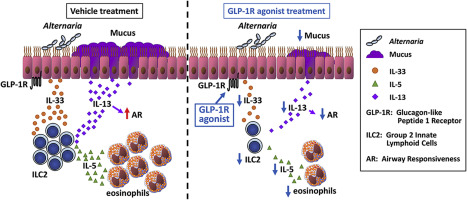Journal of Allergy and Clinical Immunology ( IF 11.4 ) Pub Date : 2018-01-10 , DOI: 10.1016/j.jaci.2017.11.043 Shinji Toki 1 , Kasia Goleniewska 1 , Sara Reiss 1 , Jian Zhang 1 , Melissa H Bloodworth 2 , Matthew T Stier 2 , Weisong Zhou 1 , Dawn C Newcomb 3 , Lorraine B Ware 3 , Gregg D Stanwood 4 , Aurelio Galli 5 , Kelli L Boyd 2 , Kevin D Niswender 6 , R Stokes Peebles 7

|
Background
IL-33 is one of the most consistently associated gene candidates for asthma identified by using a genome-wide association study. Studies in mice and in human cells have confirmed the importance of IL-33 in inducing type 2 cytokine production from both group 2 innate lymphoid cells (ILC2s) and TH2 cells. However, there are no pharmacologic agents known to inhibit IL-33 release from airway cells.
Objective
We sought to determine the effect of glucagon-like peptide 1 receptor (GLP-1R) signaling on aeroallergen-induced airway IL-33 production and release and on innate type 2 airway inflammation.
Methods
BALB/c mice were challenged intranasally with Alternaria extract for 4 consecutive days. GLP-1R agonist or vehicle was administered starting either 2 days before the first Alternaria extract challenge or 1 day after the first Alternaria extract challenge.
Results
GLP-1R agonist treatment starting 2 days before the first Alternaria extract challenge decreased IL-33 release in the bronchoalveolar lavage fluid and dual oxidase 1 (Duox1) mRNA expression 1 hour after the first Alternaria extract challenge and IL-33 expression in lung epithelial cells 24 hours after the last Alternaria extract challenge. Furthermore, GLP-1R agonist significantly decreased the number of ILC2s expressing IL-5 and IL-13, lung protein expression of type 2 cytokines and chemokines, the number of perivascular eosinophils, mucus production, and airway responsiveness compared with vehicle treatment. GLP-1R agonist treatment starting 1 day after the first Alternaria extract challenge also significantly decreased eosinophilia and type 2 cytokine and chemokine expression in the airway after 4 days of Alternaria extract challenge.
Conclusion
These results reveal that GLP-1R signaling might be a therapy to reduce IL-33 release and inhibit the ILC2 response to protease-containing aeroallergens, such as Alternaria.
中文翻译:

胰高血糖素样肽 1 信号传导抑制过敏原诱导的肺 IL-33 释放并减少体内第 2 组先天性淋巴细胞细胞因子的产生
背景
IL-33 是使用全基因组关联研究确定的与哮喘最一致的相关基因候选者之一。在小鼠和人类细胞中的研究证实了 IL-33 在诱导第 2 组先天淋巴细胞 (ILC2) 和 T H 2 细胞产生 2 型细胞因子的重要性。然而,没有已知的药物可以抑制 IL-33 从气道细胞中释放。
客观的
我们试图确定胰高血糖素样肽 1 受体 (GLP-1R) 信号传导对气源性过敏原诱导的气道 IL-33 产生和释放以及对先天 2 型气道炎症的影响。
方法
BALB/c 小鼠连续 4 天用链格孢提取物进行鼻内攻击。在第一次链格孢提取物攻击前 2 天或第一次链格孢提取物攻击后 1 天开始施用 GLP-1R 激动剂或载体。
结果
在第一次链格孢提取物攻击前 2 天开始 GLP-1R 激动剂治疗降低了第一次链格孢提取物攻击后 1 小时支气管肺泡灌洗液中的 IL-33 释放和双氧化酶 1 (Duox1) mRNA 表达和肺上皮细胞中 IL-33 的表达最后一次链格孢提取物挑战后 24 小时。此外,与载体治疗相比,GLP-1R 激动剂显着降低了表达 IL-5 和 IL-13 的 ILC2 的数量、2 型细胞因子和趋化因子的肺蛋白表达、血管周围嗜酸性粒细胞的数量、粘液产生和气道反应性。GLP-1R 激动剂治疗在第一个链格孢后 1 天开始在链格孢提取物攻击4 天后,提取物攻击还显着降低了气道中的嗜酸性粒细胞增多和 2 型细胞因子和趋化因子的表达。
结论
这些结果表明,GLP-1R 信号传导可能是一种减少 IL-33 释放和抑制 ILC2 对含蛋白酶气变应原(如链格孢)的反应的疗法。











































 京公网安备 11010802027423号
京公网安备 11010802027423号